여드름(좌창), 여드름에 관한 백문 백답, Acne, One Hundred Qs &As on acne
- 심상성 여드름은 전 세계 인구의 약 9%, 12-24세 인구의 약 85%에 영향을 미칩니다.
- 여드름(좌창)은 자궁 내 태아기에서부터 노년기까지 모든 연령층의 남녀노소 누구에게나 날 수 있는 일종의 피부병이다.
- 사춘기 아이들과 청년들의 85%에게 경도내지 중등도 여드름이 난다 23.
- 여드름은 보통 여드름(Acne vulgaris), 응괴성 여드름, 뭉친 여드름(Acne conglobata), 두창상 여드름(Acne varioliformis), 속립성 괴사성 여드름(Acne necrotica miliaris), 열대성 여드름(Acne tropica), 영아성 여드름(Infantile acne)을 구분 할 수도 있고 그 중 한두 가지의 종류의 여드름이 함께 있는 혼합형 여드름도 있다.
- 이상 열거한 여드름 중 한 종류나 두 종류의 여드름이 누구에게든지 일생 동안 적어도 한번 정도는 날 수 있다.
- 여드름이 어떤 가족들에게는 다른 가족들에게보다 더 심하게, 또 더 많이 날 수 있다.
- 여드름은 얼굴에는 물론이고 두피, 등, 앞가슴, 위팔 등에 날 수 있다.
- 아토피성 피부염과 여드름이 동시 날 수 있다.
- 피부에 피지가 더 많이 분비되거나 머리에 기름기가 더 많다고 해서 여드름이 더 많이 나는 것은 아니다.
- 겨울철에 여드름이 더 심하게 날 수 있다.
- 호르몬 분비에 따라 여드름이 더 심해질 수 있다.
- 특히 여성의 여드름은 호르몬의 분비의 영향을 더 많이 받는다.
여드름(좌창)의 원인
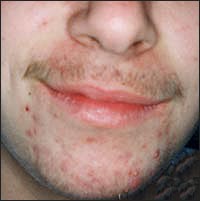
사진 517. 사춘기 남아에게 생긴 여드름
Copyrightⓒ 2001 John Sangwon Lee,MD., FAAP
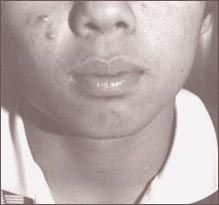
사진 518. 사춘기 남아의 여드름
Copyrightⓒ 2001 John Sangwon Lee,MD., FAAP
- 여드름은 10~20세 연령층 사춘기 아이들이나 젊은이들에게 더 잘 나는 생리적 피부병이다.
- 여드름은 감염병도 아니고, 내분비 질환도 아니다.
- 여드름이 나는 병리 생리기전에 대하여 잘 알면 여드름을 더 쉽게 치료할 수 있다.
- 그래서 여드름이 생기는 병리 생리 기전에 관해서 여기에서 설명한다.
- 그림 518, 520, 521, 602에서 볼 수 있듯이 피부 표면에 털(체모) 구멍, 땀, 피지, 분비관 구멍들이 정상적으로 있고, 피부층의 표피층의 아래에 있는 진피층에 피부지방(피지)을 분비하는 피지선이 있다.
- 피지선에서 피부지방(피지)이 분비되고 피지는 피지선 분비관과 털구멍의 옆에 있는 피지선 구멍을 통해 피부층의 표면으로 분비되는 것이 정상적 생리다.
- 피지선은 손, 발바닥을 제외하고 거의 모든 피부층에 분포되어 있고 얼굴, 가슴, 어깨 부위 피부층에 특히 더 많이 분포 되어있다.
- 사춘기가 시작될 때 남아들의 고환, 여아들의 난소, 부신 피질에서 안드로젠(안드로겐/ Androgen) 남성 호르몬이 왕성하게 분비된다.
- 이렇게 분비된 남성 호르몬으로 피지선이 자극 받아 피지가 더 많이 분비된다.
- 피지선에서 분비된 피지는 피부 표피층에 있는 체모 구멍 부위에 있는 작은 피지 분비관을 통해서 피부층의 표면으로 분비되어 나온다.
- 어떤 때는 마르고 딱딱한 케라틴(Keratin) 이란 피부 단백질로 피지 분비관의 일부 또는 전부가 완전히 또는 불완전하게 막힐 수 있다.
- 이 때 막힌 피지 분비관의 부위 아래에 있는 피지 분비관 속에 피지가 가득 차 있을 때 여드름이 생긴다.
- 이 피지 분비관이 완전히 막힐 때는 여드름의 끝 부위가 약간 하얗다.
- 이 여드름을 비염증성 폐쇄형 면포(Noninflammatory closed comedones) 또는 흰 여드름(Whiteheads)이라 한다.
- 그 피지 분비관의 입구가 완전히 다 막히지 않고 조금 열려 있을 때 생긴 여드름 끝 부위 색은 검을 수 있다.
- 이 여드름은 비염증성 개방형 면포(Noninflammatory open comedones) 또는 검은 여드름(흑색 면포/Blackheads)이라 한다.
- 여드름이 낭종성이 될 수 있다.
- 낭종성 여드름은 피부층 깊숙이 나는 것이 보통이다.
- 피부에는 코리네 박테리아(프로피오니 박테리아/Propionibacterium acnes), 또는 황색 포도상구균 등 여러 종류의 박테리아가 정상적으로 상존한다.
- 여러 종류의 박테리아들 중 코리네 박테리아가 피지선에 주로 감염되어 피지선이 감염되면 여드름이 곪게 된다.
- 그래서 염증성 구진(Inflammatory papules) 여드름, 농포(Pustules) 여드름, 결절(Nodules) 여드름, 낭종(Cysts) 여드름 등이 생길 수 있다.
- 모든 여드름이 다 곪지는 않지만 특히 잘 곪는 여드름이 있다.
- 여드름의 크기도 여러 가지이다. 어떤 것은 쌀알만 하다.
- 때로는 박테리아가 감염되어 곪은 여드름에 고름이 잡히기도 한다.
- 다행히도 사춘기 아이들의 여드름의 대부분은 곪지 않는다.
- 그러나 어떤 아이들의 여드름은 심하게 곪을 수 있다.
- 곪은 여드름을 적절히 잘 치료하지 않으면 나중에는 얼굴에 흉터가 생기고 그 흉터는 평생 동안 없어지지 않을 수 있다.
- 곪은 여드름이 전 피부층 깊숙이 퍼지고 여드름이 붉고 노랗게 곪을 수 있다.
- 이런 여드름을 속히 적절히 치료하지 않으면 아이들에게 큰 근심걱정거리가 될 수 있다.

그림 518. 피부 해부도.
Copyrightⓒ 2001 John Sangwon Lee, MD., FAAP
여드름의 종류
1.보통 여드름(Acne vulgaris)
2. 응괴성 여드름(Acne conglobata)
3. 두창상 여드름(Acne varioliformis)
4. 속립성 괴사성 여드름(Acne necrotica miliaris)
5. 열대성 여드름(Acne tropica)
6. 영아성 여드름(Infantile acne) 등으로 나누기도 한다. 또,
7. 비염증성 폐쇄형 면포(Noninflammatory closed comedones), 또는 흰 여드름(Whiteheads)
8.비염증성 개방형 면포(Noninflammatory open comedones), 또는 검은 여드름(Blackheads)
9. 염증성 구진성 여드름(Inflammatory papule acne)
10.농포성 여드름(Pustules acne)
11. 결절성 여드름(Nodula acne)
12. 염증성 낭종성 여드름(Cystic acne)
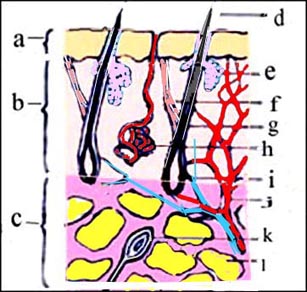
그림 520. 피부 해부도.
a-표피층, b-진피층, c-피하 조직층, d-체모, e-피지선, f-발기모근(입모근) g-모간, h-땀샘, i-모낭, j-모세혈관, k-말초 신경, l-피하 지방.
Copyrightⓒ 2001 John Sangwon Lee, MD., FAAP
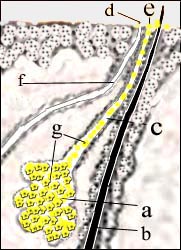
그림 521. 피지선과 피부 단면도.
a-피지선(피부 지방선), b-모간, c-피지선 분비관, d-땀샘 구멍, e-피지선 구멍, f-땀샘 분비관, g-피지.
Copyrightⓒ 2001 John Sangwon Lee,MD., FAAP
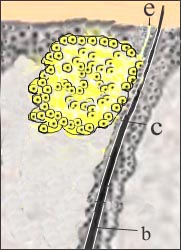
그림 522. 경도 여드름.
피지선 관이 각화된 케라틴으로 많이 막히면 여드름이 생길 수 있다. b-모간, c-피지선 관, e-피지선 분비구멍.
Copyrightⓒ 2001 John Sangwon Lee,MD. FAAP
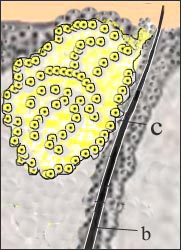
그림 523. 폐쇄성 여드름.
c-여드름이 생긴 피지선, b-모간.
Copyrightⓒ 2001 John Sangwon Lee, MD., FAAP
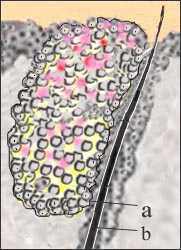
그림 524. 피지선 관이 케라틴으로 막히고 피지선에 박테리아가 침범해 피지선이 곪으면 농포성 여드름이 된다.
a- 곪은 피지선, b-모간. Copyrightⓒ 2001 John Sangwon Lee, MD., FAAP
여드름(좌창)의 증상 징후
- 여드름은 사춘기의 아이들에게도 날 수 있고 신생아들이나 성인들에게도 날 수 있다.
- 신생아들의 여드름은 자궁 속에서 모체로부터 받은 안드로겐 호르몬의 영향 때문에 난다. 이것을 신생아 여드름이라고 한다
- 여드름이 사춘기에 시작할 때, 나이로는 대개 10세 전후부터 나기 시작한다.
- 그 후 사춘기부터 20세 전후의 청소년기에 있는 사춘기 아이들과 젊은 남녀들에게 가장 심하게 날 수 있다.
- 여드름이 처음 나기 시작한 나이가 어리면 어릴수록 여드름은 더 오랫동안 계속 나고 더 심하게 난다.
- 여드름은 여름철보다 겨울철에 더 심하다.
- 여아들의 여드름은 월경과 관련이 있다.
- 그래서 월경이 시작하기 바로 며칠 전에 더 심해지는 것이 보통이다.
- 초콜릿이나 그 밖에 다른 몇 가지 음식물을 먹으면 여드름이 더 심해 질 수 있다고 주장하지만, 음식물과 여드름의 중증도에는 거의 관련이 없다고 한다.
- 앞서 설명한 것과 같이 어떤 여드름은 빨간 피부 발진과 비슷하고, 어떤 여드름은 좁쌀만 한 구진과 같고, 또 어떤 여드름은 노랗게 곪을 수 있다.
- 여드름이 심하게 곪을 때는 전 피부층 깊이 여드름 고름 주머니가 생길 수 있다.
- 그 고름 주머니가 터지면 고름이 흘러나올 수 있다.
- 여러 개 곪은 여드름이 서로 한데 엉겨 붙기도 한다.
- 곪은 여드름을 짜면 노란 고름이나 피고름이 난다.
- 이런 여드름을 적절히 치료하면 잘 나을 수 있지만, 치료를 적절히 잘 하지 않으면 계속 더 심하게 곪을 수 있다.
- 사춘기 아이들, 특히 사춘기 여아들은 자신의 신체상에 관심이 많다. 그래서 얼굴에 어떤 반점 하나만 있어도 고민 하는 것이 보통이다. 특히 사춘기 여아들은 여드름이 조금만 나더라도 근심 걱정을 많이 한다.
- 여드름은 2차 성징이 나타나기 시작하는 징후의 하나이다.
- 그래서 얼굴에 여드름이 날 때 사춘기 남녀 아이들은 수줍어하기도 한다.
- 그렇지만 대부분의 사춘기 아이들은 여드름이 나 있기 때문에 걱정을 많이 하면서도 부모에게 여드름을 치료 하는 데 도움을 요청하기를 꺼려한다.
- 그 대신 혼자서 시간만 있으면 거울 앞에서 여드름을 짜기도 하고 고민하게 된다.
- 얼굴에 여드름이 나는 동시에 작은 뾰루지도 함께 날 수 있다.
- 대부분의 사춘기 아이들은 자기들이 여드름 치료약을 사서 자신이 치료하기도 한다.
여드름(좌창)의 진단
- 병력, 증상 징후와 진찰소견을 종합하여 진단한다.
여드름(좌창) 치료
- 1차 요법은 국소 레티노이드, 벤조일 퍼옥사이드, 아젤라산 또는 국소 병용 요법입니다. 더 심각한 질병의 경우 독시사이클린 또는 미노사이클린과 같은 경구 항생제 또는 복합 경구 피임제 또는 스피로노락톤과 같은 호르몬 요법. 또는 이소트레티노인이 가장 효과적입니다.
- 여드름은 사춘기 아이들 누구에게나 자연적으로 생기는 정상적 피부 변화로 잘못 알고 있는 부모들도 많다.
- 바로 이런 이유로 부모들이 사춘기 자녀들의 여드름을 적절히 치료하지 않을 수 있고
- 그 외 다른 이유로 사춘기 자녀들의 여드름을 적절히 치료 않지 않고 그대로 방치하는 경우도 있다.
- 여드름을 적절히 치료하지 않으면 흉터가 얼굴에 생겨 외관상으로도 보기가 좋지 않을 뿐만 아니라 그로 인해 일생동안 정신 정서적 심리적 면에 크게 타격 받을 수 있다.
- 사춘기 자녀들에게 난 여드름이 경미해도 부모들은 많은 관심을 갖고 그들의 여드름을 적절히 바로 치료를 주어야 한다.
- 심하지 않은 경미한 여드름의 대부분은 아침저녁으로 보통 비누로 얼굴을 씻는 것만으로 잘 치료될 수 있다.
- 과도히 비벼 닦거나 때 미는 식으로 얼굴을 닦으면 오히려 여드름이 더 곪을 수 있다.
- 음식물 치료는 여드름 치료에 별로 효과가 없다.
약리작용에 의한 여드름 치료제
1. 국소용 치료제
- Benzoyl Peroxide
-
- 처방 없이 살수 있고 처방으로도 살수 있다.
- 항염증작용, 살균작용, 여드름집 용해작용이 있다.
- 로숀, 젤, 비누, 세정제형이 있다.
- 2.5% 3%, 4%, 5%, 6%, 8%, 10% 강도가 있다.
- 국소 단가 항생제
-
- 항염증작용과 살균작용이 있다.
- Clindamycin과 Erythromycin제가 있다.
- 로션, 젤, 연고, 외용 거즈형 등이 있다.
- 국소 종합 항생제
-
- Benzoyl Peroxide와 항생제 종합제
- 항염증작용, 살균작용, 여드름 집 용해작용이 있다.
- Benzoyl Peroxide + Clindamycin제와 Benzoyl Peroxide + Erythromycin제가 있다.
- 국소용 Retinoids
-
- 비염증성 여드름 집 용해작용이 있다.
- 모낭 상피세포가 정상적으로 표피탈락하게 하는 작용이 있다.
- 경미한 항염증작용이 있다.
- 크림형, 젤형, 외용 거즈 등이 있다.
2. 전신 치료용
- 경구용 항생제
-
- 항염증작용과 살균작용이 있다.
- 중등도 여드름 내지 중증 여드름 치료에 쓴다.
- Tetracycline 250~500mg을 1일 2회
- Doxycycline 50~100mg을 1일 2회 내지 2회,
- Minocyline 50~100mg을 1일 2회 내지 2회
- Erythromycin 250~500mg을 1일 2회
- 경구용 피임제
-
- 안드로젠 혈중농도를 감소시킨다.
- 프로제스틴(Progestins)제로 치료할 수 있다.
- Isotretinoin(13-cis-retinoic acid)
-
- 피지 생성을 감소시키고 극심한 여드름 치료에 사용한다.
- 경구용 Isotretinoin의 상품명은 ACCUTANE(Amnesteem)이다.
- 보통 20~24주간 치료한다. 소스와 참조 :National Campaign to Control Acne
곪지 않은 여드름은 다음 1.~3. 과 같이 치료하는 것이 보통이다.
1. 레티노익 산(Retinoic Acid)겔이나 액으로
2. 벤조일 펄옥사이드(Benzoyl peroxide) 크림이나 겔로
3. 비타민 A산(레틴-A) 겔이나 액으로 치료하고,
곪은 여드름은 다음 4.~8.과 같이 치료하는 것이 보통이다.
4. 2% 에리스로마이신 액이나 연고나 겔,
5. 크레오신 액이나 로션,
6. 설파제 크림이나 살리실릭산 크림이나 겔 중 한 가지,
7. 또는 Benzoyl Peroxide + Erythromycin나, Benzoyl Peroxide + Clindamycin, 또는 Benzoyl Peroxide + glycolic acid 등 여드름 치료제로 치료하기도 하고, 두 종류의 항생제 여드름 치료제를 함께 발라 치료할 수도 있다.
8. Adapalene cream이나 Adapalene gel 0.1%로 치료하기도 한다.
-
- 대개 치료 시작 후 2~4주경 많이 좋아지는 것이 보통이다.
- 새 여드름이 나지 않을 때까지 계속 치료한다.
- 더 이상 새 여드름이 나지 않으면 여드름 치료제의 용량과 치료의 횟수를 점차 줄이다가 마지막으로 더 이상 치료를 하지 않는 식으로 치료한다.
- 그러나 이런 치료도 어디까지나 의사의 지시에 따라 한다.
심하게 곪은 여드름은 다음 9.~11. 여드름 치료제로 치료 하는 것이 보통이다.
9. 에리스로마이신 국소용 여드름 항생제 물약이나 클린다마이신 국소용 여드름 항생제 물약을 발라 치료할 수 있다.
10. 또 테트라사이클린, 에리스로마이신, Minocycline, Trimethoprim-sulfamethoxazole, 또는 독시사이클린 등 전신용 경구용 항생제 중 한 가지를 선택해 경구로 복용해서 여드름을 치료할 수 있다.
11. 또 더 심하게 곪은 여드름은 전신용 경구용 항생제, 국소용 항생제 또는 레티노이드 크림 등으로 3개월 동안 치료하면 잘 낫는 것이 보통이다.
-
- 이상 설명한 여드름 치료로 여드름이 치료되지 않으면 마지막으로 아큐탄(Accutane) 여드름 치료약으로 여드름을 치료할 수 있다.
- 강한 햇볕을 쏘이든지 단파 레이저치료, 또는 장파 레이저로 치료 할 수 있다.
- 어떤 종류의 여드름이든 최선 치료 방법으로 아무리 적절히 치료를 해도 금방 완치가 안 되고 일정한 기간이 지나야 완치될 수 있다.
- 대부분의 여드름은 집에서 치료할 수 있는 단순한 피부병이 아니다. 의사의 지시와 적절한 여드름 치료약으로 적극적인 치료를 해야 한다.
심하지 않은 여드름의 일반적 치료
- 레틴-A 겔 등을 발라 치료하고, 좀 더 심한 여드름은 벤조일 펄옥사이드 크림이나 겔을 발라서 치료한다.
- 구진이 생기거나 곪은 여드름은 비타민 A, 벤조일 펄옥사이드 크림 및, 또는 항생제 액 등을 발라서 치료하고 아주 심할 때는 경구용 항생제로 치료한다.
여드름을 다음 약으로 치료해 볼 수 있다.
- 건선 치료에 사용했던 타자로텐(Tazarotene/Tazorac)으로 염증성 여드름이나 면포성 여드름을 치료하면 효과가 좋다는 보고가 있다.
- 타자로텐은 레티노이드의 일종이고 여드름이 난 피부에 하루걸러 발라 치료한다.
- Benzaclin 국소용 젤(clindamycin 1%-benzoyl peroxide 5% gel)도 여드름 치료제의 신약이다.
- Epiduo(Galderma)와 Acanya(Arcutis Pharmaceuticals)으로 치료할 수 있다.
- 유지 여드름 치료제에는- 국소적 Retinoid +/- Benzoyl peroxide 또는 Benzoyl peroxide/국소적 항생제 치료
- 면포성 여드름-(Comedonal acne), 구진성/농포성 여드름-(Papular/Pustular acne), 소결절성 여드름-(Nodular acne)
표 12. 여드름 약물치료 용병학 2009 년 Acne treatment strategy 2009년
| – | 경도 여드림
면포성 |
경도 여드림
구진/농포성 |
중등도 여드름
구진성/농포성 |
중등도 여드름
소결절성 |
중증 여드름
소결절성 |
| 첫째 선택 | 국소적 retinoid | 국소적 retinoid + Benzoyl peroxide 또는 Benzoyl peroxide/국소적 항생제 치료 | 국소적 retinoid + 경구 항생제 + Benzoyl peroxide 또는 Benzoyl peroxide/국소적 항생제 치료 | 국소적 retinoid + 경구 항생제 + Benzoyl peroxide 또는 Benzoyl peroxide/국소적 항생제 치료 | 경구 isotretinoin |
| 교체 치료 | salicylic acid | – | – | 경구 isotretinoin | 국소적 retinoid + 경구 항생제 + Benzoyl peroxide 또는 Benzoyl peroxide/국소적 항생제 치료 |
| 여성 여드름을 위한 교체 치료 | – | – | 호르몬 치료 + 국소적 retinoid +/- Benzoyl peroxide 또는 Benzoyl peroxide/국소적 항생제 치료 | -호르몬 치료 + 국소적 retinoid +/- Benzoyl peroxide 또는 Benzoyl peroxide/국소적 항생제 치료 | 호르몬 치료 + 경구 항생제 + 국소적 retinoid +/- Benzoyl peroxide 또는 Benzoyl peroxide/국소적 항생제 치료 – |
출처 및 참조문헌
– Contemporary Pediatrics, March 2009. Pediatric acne, Advances in tratmeny p.6
– Others
표 13. 여드름 치료용 종합 약물 Combination Acne treatment drugs
| 여드름 치료용 종합 약물의 종류 | 치료 횟수 |
| 3% erythromycin/ 5% Benzoyl peroxide gel | 1 일 2회 |
| 1% Clindamycin phosphate/ 5% Benzoyl peroxide gel | 1 일 1회 또는 2회 |
| 0.025% tretinoin/ 1.2% Clindamycin phosphate gel | 1 일 1회 |
| 0.1% Adapalene / 2.5% Benzoyl peroxide gel | 1 일 1회 |
출처-Contemporary pediatrics, March 2009. Pediatric acne, Advances in tratmeny p.7
소아청소년 여드름 권장치료 Recommendation for the treatment of pediatric acne 2013
|
증세에 따른 여드름 분류 |
경도 여드름 |
중등도 여드름 |
중증 여드름 |
|
여드름의 종류에 따른 여드름의 증상 징후 |
여드름 집(면포)이나 여드름 염증이 있거나 또는 이 두 징후가 있는 혼합형 여드름. 사춘기 되기 전 소아들이나 초가 사춘기 아이들에게 흔히 볼 수 있는 경도 여드름. 얼굴의 중앙 부위에 나는 것이 보통이다. |
여드름 집(면포)과 염증이 경도 여드름이 있을 때보다 더 심하다. |
심한 염증과 결절성 여드름 환부가 광범위하게 생겨있는 아주 심한 여드름. 상흔도 생길 수 있다. |
|
권장 최초 치료 1 |
국소제 혼합치료 Benzole peroxide 국소제 치료 또는 Retinoids 국소제 치료
|
국소제 혼합치료 Retinoids국소제치료 + Benzole peroxide 국소제치료 또는 Retinoids 국소제치료 + (Benzole peroxide 국소제치료+ 국소제 항생제 치료) 또는 (Retinoids 국소제치료+ 국소 항생제 치료) +Benzole peroxide 국소제 치료 |
국소 전신성 혼합치료 경구용 항생제 치료 + Retinoids 국소제 치료 + Benzole peroxide 국소제 치료 +/- 국소용 항생제 치료 |
|
또는 권장 최초 치료 2
|
국소제 혼합치료 Benzole peroxide 국소제 치료+항생제 국소치료 또는 Retinoids 국소제 치료 + Benzole peroxide 국소제 치료 또는 Retinoids 국소제 치료+ Benzole peroxide 국소제 치료 + 항생제 국소제 치료 |
경구용 항생제 + retinoids 국소제치료 + Benzole peroxide 국소제치료 또는 Retinoids 국소제치료 + 국소용 항생제 치료 +Benzole peroxide 국소용 치료 |
|
|
그 외 치료는 제17권 여드름 참조 |
|
|
|
소스: Eichenfield Lf. Krakowski AC, Piggot C, et al. Pediatrics, 2013
Copyright ⓒ 2014 John Sangwon Lee, MD ., FAAP
“부모도 반의사가 되어야 한다”-내용은 여러분들의 의사로부터 얻은 정보와 진료를 대신할 수 없습니다.
“The information contained in this publication should not be used as a substitute for the medical care and advice of your doctor. There may be variations in treatment that your doctor may recommend based on individual facts and circumstances.
“Parental education is the best medicine.“
여드름관한 백문 백답 Acne One Hundred Qs &As
Q
얼굴 여드름을 여드름 치료약으로 적절히 치료할 때 며칠 걸리면 좋아지나요?
A.
얼굴 여드름을 적절한 여드름 치료약으로 치료를 시작한 후 6주되면 낫기 시작하는 것이 보통이나 때로는 몇 주 더 걸리고, 가슴 여드름이나 등에 난 여드름은 그 보다 더 오래 걸려서 치료 효과가 다 나기 시작하는 것이 보통입니다.
Q
내 얼굴이 백 프로 정상으로 돌아갈 수 있나요?
A.
최근 여드름 치료약으로 잘 치료하면 상당히 효과가 있으나 드물게는 여드름이 또 다시 생길 수 있습니다.
Q
여드름 국소 치료약으로 치료 받는 중 좋아졌다가 더 이상 좋아지지 않으면 어떻게 하나요?
A.
필요에 따라 다른 종류의 여드름 국소 치료약으로 바꿔 치료하든지 경구용 여드름 치료약 등으로 치료할 수 있습니다.
Q
Isotretinoin 여드름 치료약의 흔한 부작용은 무엇이고 그 약으로 치료한 후 생길 수 있는 부작용은 무엇인가요?
A.
Isotretinoin의 상품명에는 Accutane, Sotret, Claravis, 또는 Amnesteem 등이 있다.
Isotretinoin의 가장 흔한 부작용은 피부 건조증과 비강 점막층 건조이고, 때로는 코피, 안구건조, 피부의 자극, 일광에 이상 감수성 증가, 일시적인 여드름 악화, 근육통, 관절통, 태아 기형, 간기능 이상, 혈지방 장애, 우울증, 자살기도 등의 부작용이 생길 수 있습니다.
Q
Isotretinoin 여드름 약으로 치료해서는 안 되는 사람은?
A.
임신부, 임신을 하려고 계획하는 여성, 임신한 것 같은 여성, Isotretinoin 여드름 치료약의 부작용이나 사용법 등을 이해하지 못하거나 사용법을 따르지 않을 사람은 Isotretinoin 여드름 약으로 여드름을 치료할 수 없습니다.
Q.
sotretinoin 여드름 약으로 여드름을 치료하는 중 비타민 A나 비타민 A를 보충제로 써서는 안 되나요?
A.
그렇습니다.
Q
Isotretinoin 여드름 약을 얼마동안 써야하나요?
A.
16~20주 치료하면 효과가 좋아지는 것이 보통입니다.
그 후 오랫동안 여드름이 나지 않다가 다시 날 수 있습니다.
그 후 다시 같은 치료를 반복하여 받을 수 있습니다.
Q
얼굴을 자주 닦으면 여드름이 좋아지고 예방되나요?
A.
그렇지 않습니다. 무지방 메이크업, 무지방 피부 두발 케어는 권장합니다.
Q
불결, 초코렛트, 소다, 단 음식물, 또는 지방질 음식물이 여드름의 원인이 될 수 있나?
A.
불결, 초코렛트, 소다, 단 음식물, 또는 지방질 음식물이 여드름을 일으키지 않는다.
Q
여드름을 많이 닦으면 더 잘 낫나?
A.
더 잘 낫지 않는다.
Q
나이 어린 아이들의 여드름을 isotretinoin과 항생제로 치료 할 수 있나?
A.
치료 할 수 있다.
소스: National campaign to Control Acne
Q
여드름 전신적 치료용 항생제에는 어떤 종류가 있나?
A. Tetracycline, Doxycycline, Minocycline, Erythromycin 등이다.
Q
얼굴을 자주 닦으면 여드름이 좋아지고 예방되나요?
A.
그렇지 않습니다. 무지방 메이크업, 무지방 피부 두발 케어는 권장합니다.
Q
심한 여드름으로 인해 정신 사회기능 장애가 생길 수 있나?
A.
여드름으로 인해 우울증, 불안, 분노, 불만족, 당혹, 사회 위측증 등 정신 사회 기능장애가 생길 수 있다.
Acne Vulgaris
100 questions about acne, acne 100 answers about acne,
• Vulgaris affects approximately 9% of the world’s population and approximately 85% of 12-24 year-olds.
• My cramped people have strong bloodlines until old age.
• 85% of young people with photos are filial to moderate 23.
• General settlement (Acne vulgaris), department stores (Acne conglobata), smallpox (Acne varioliformis), milia (Acne necrotica miliaris), Infant recovery agent (Acne tropica), (Acne in infants) It seems to take a lot of time.
• The type of donna you can use for maximum performance.
• More benefits for families.
• Competition is fierce, competition is fierce.
• Atopic dermatitis and recovery period.
• A summary of the Asian economy.
• A better day. • Excellent efficacy.
• Better effect of this product. Causes of (acne) picture 517.

Picture 517. Copyrightⓒ 2001 Lee Sang-won Lee Sang-won, MD., FAAP

Photo 518. Photographer’s Recommendation Copyrightⓒ 2001 Lee Sang-won Lee Sang-won, MD., FAAP
• Acne is a physiological skin disease that is more common among adolescents and young people aged 10 to 20 years. • Acne is neither an infectious disease nor an endocrine disease.
• Acne pathology Acne can be treated more easily if you know about the menstrual mechanism.
• So the pathophysiology of acne is explained here.
• As can be seen in Figures 518, 520, 521, and 602, pores, sweat, sebum, and glandular pores are normally present on the skin surface, and the There are sebaceous glands.
• It is normal physiology that skin fat (sebum) is secreted from the sebaceous glands and sebum is secreted to the surface of the skin layer through the sebaceous gland secretion duct and the sebaceous gland hole next to the hair follicle.
• The sebaceous glands are distributed in almost all skin layers except for the hands and soles of the feet, and especially in the skin layers in the face, chest, and shoulder areas.
• At the onset of puberty, the testes of boys, the ovaries of girls, and the adrenal cortex secrete androgens, male hormones.
• The sebaceous glands are stimulated by this secreted male hormone, and more sebum is secreted.
• Sebum secreted from the sebaceous glands is secreted to the surface of the skin layer through the small sebaceous glands located in the hair pores in the epidermal layer of the skin.
• Occasionally, some or all of the sebaceous glands can be completely or incompletely blocked by a skin protein called keratin, which is sometimes dry and hard.
• At this time, acne occurs when sebum is filled in the sebaceous glands under the blocked sebaceous glands.
• When this sebaceous gland is completely blocked, the tip of the pimple is slightly white.
• These acne are called Noninflammatory closed comedones or Whiteheads.
• When the entrance of the sebaceous duct is not completely blocked, but is slightly open, the color of the tip of the acne may be black.
• These acne are called Noninflammatory open comedones or Blackheads.
• Acne can become cystic.
• Cystic acne usually develops deep into the skin layer.
• Several types of bacteria, such as coryne bacteria (Propionibacterium acnes) or Staphylococcus aureus, are normally present on the skin.
• Among the various types of bacteria, coryne bacteria mainly infects the sebaceous glands, and when the sebaceous glands become infected, acne develops.
• This can lead to Inflammatory papules acne, Pustules acne, Nodules acne, Cysts acne, etc.
• Not all acne breakouts, but some are particularly prone to acne breakouts.
• Pimples come in different sizes. Some are the size of a grain of rice.
• Occasionally, pus can form in the pimples that are infected with bacteria.
• Fortunately, the majority of acne in adolescents does not develop.
• However, acne in some children can be severe.
• If not properly treated, acne scars will eventually form on your face, which may not go away for the rest of your life.
• Burnt acne spreads deep into the entire skin layer, and acne can turn red and yellow.
• If not treated promptly and properly, these acne can be a major concern for children.

Figure 518. Skin anatomy. Copyrightⓒ 2001 John Sangwon Lee, MD., FAAP
types of acne
1. Common acne (Acne vulgaris)
2. Acne conglobata
3. Acne varioliformis
4. Acne necrotica miliaris
5. Acne tropica
6. It is also divided into infantile acne. also,
7. Noninflammatory closed comedones, or Whiteheads
8. Noninflammatory open comedones, or Blackheads
9. Inflammatory papule acne
10. Pustules acne
11. Nodula acne
12. Cystic acne

Figure 520. Skin anatomy. a-epidermal layer, b-dermis layer, c-subcutaneous tissue layer, d-body hair, e-sebaceous gland, f-pillar root, g-hair shaft, h-sweat gland, i-hair follicle, j-capillary blood vessel, k-peripheral nerve, l – subcutaneous fat. Copyrightⓒ 2001 John Sangwon Lee, MD., FAAP

Figure 521. Sebaceous gland and skin cross-section. a – sebaceous gland (sebaceous gland), b – hair shaft, c – sebaceous gland duct, d – sweat gland pore, e – sebaceous gland pore, f – sweat gland duct, g – sebum. Copyrightⓒ 2001 John Sangwon Lee, MD., FAAP

Figure 522. Mild acne. Acne can occur when the sebaceous gland ducts become clogged with keratinized keratin. b-hair shaft, c-sebaceous gland duct, e-sebaceous gland pore. Copyrightⓒ 2001 John Sangwon Lee, MD., FAAP

Figure 523. Obstructive acne. c – acne-prone sebaceous glands, b – hair shaft. Copyrightⓒ 2001 John Sangwon Lee, MD., FAAP

Fig. 524. When the sebaceous gland is blocked with keratin and bacteria invade the sebaceous gland, the sebaceous gland becomes stagnant, resulting in pustular acne. a- sebaceous glands, b- hair shafts. Copyrightⓒ 2001 John Sangwon Lee, MD., FAAP
Symptoms, signs of Acne (acne)
• Acne can affect adolescents, newborns, and adults.
• Acne in newborns is caused by the influence of androgen hormones received from the mother in the womb. This is called neonatal acne.
• When acne starts in puberty, it usually starts around the age of 10.
• Then, from puberty to adolescence around the age of 20, it can be most severe in adolescents and young men and women.
• The younger you are when you first start having acne, the longer it will last and the more severe it will be.
• Acne is worse in winter than in summer.
• Acne in girls is related to menstruation.
• So it usually gets worse just a few days before menstruation starts.
• It is argued that eating chocolate and some other foods can make acne worse, but there is little association between food and acne severity.
• As mentioned above, some pimples are like red skin rashes, some pimples are like papules the size of a millet, and some pimples can turn yellow.
• When acne is severe, acne pus pockets can form deep in the entire skin layer.
• If the pus bag ruptures, pus can leak out.
• Multiple pimples may stick together.
• Squeezing the pimples produces yellow or bloody pus.
• this acne can get better with proper treatment, but if not treated properly, they can continue to get worse.
• Adolescent children, especially adolescent girls, are very interested in their body image. So, it is common to worry if there is only one spot on the face. In particular, adolescent girls worry a lot even if they have even a small amount of acne.
• Acne is one of the signs that secondary sexual characteristics begin to appear.
• That’s why teenage boys and girls are shy when they get acne on their faces.
• However, most adolescents are very concerned about acne because they have it, but they are reluctant to ask their parents for help with acne.
• Instead, if you have time alone, you can squeeze acne in front of the mirror and worry.
• You may have pimples on your face and small pimples at the same time.
• Most adolescents buy their own acne medication and treat it themselves.
8. It is sometimes treated with Adapalene cream or Adapalene gel 0.1%.
o In general, it usually improves a lot about 2 to 4 weeks after the start of treatment.
o Continue treatment until no new pimples appear.
o If new acne does not appear anymore, gradually reduce the amount of acne treatment and the number of treatments, and finally, no more treatment.
o However, this treatment should only be carried out according to the doctor’s instructions. Severely stinging acne is on the following 9.~11. It is usually treated with acne medications.
9. It can be treated with erythromycin topical acne antibiotic solution or clindamycin topical acne antibiotic solution.
10. You can also take one of the systemic oral antibiotics such as tetracycline, erythromycin, minocycline, trimethoprim-sulfamethoxazole, or doxycycline orally to treat acne.
11. In addition, severe acne is usually better treated with oral systemic antibiotics, topical antibiotics, or retinoid creams for 3 months.
o If the acne treatment described above does not cure acne, finally, acne can be treated with Accutane acne treatment. o It can be treated with strong sunlight, short-wave laser treatment, or long-wave laser treatment.
o Any type of acne cannot be cured immediately no matter how properly treated with the best treatment method, and can only be cured after a certain period of time.
o Most acne is not a simple skin disease that can be treated at home. It should be actively treated with the advice of a doctor and appropriate acne medication.
A common treatment for mild acne
- First-line therapies are topical retinoids, benzoyl peroxide, azelaic acid, or combinations of topicals. For more severe diseases, oral antibiotics such as doxycycline, or minocycline or hormonal therapy such as combination oral conceptive agents or spironolactone. or isotretinoin are most effective
• Treat with Retin-A gel, etc., and for more severe acne, apply benzoyl peroxide cream or gel.
• Acne with papules or sores is treated with vitamin A, benzoyl peroxide cream and/or antibiotic solution, and in severe cases treated with oral antibiotics. Acne can be treated with the following medications:
• Tazarotene/Tazorac, which has been used to treat psoriasis, has been reported to be effective in treating inflammatory or comedonal acne.
• Tazarotene is a type of retinoid and is applied to acne-prone skin every other day for treatment.
• Benzaclin topical gel (clindamycin 1%-benzoyl peroxide 5% gel) is also a new treatment for acne.
• It can be treated with Epiduo (Galderma) and Acanya (Arcutis Pharmaceuticals).
• Maintenance acne treatments include – topical Retinoid +/- Benzoyl peroxide or Benzoyl peroxide/topical antibiotic treatment
• Comedonal acne, Papular/Pustular acne, Nodular acne
Table 12. Acne treatment strategy 2009
표 12. 여드름 약물치료 용병학 2009 년 Acne treatment strategy 2009년
| – | 경도 여드림
면포성 mild acne comedonal |
경도 여드림
구진/농포성 mild acne papule/pustular |
중등도 여드름
구진성/농포성 moderate acne papular/pustular |
중등도 여드름
소결절성moderate acne nodularity |
중증 여드름
소결절성 severe acne small nodularity |
| 첫째 선택
first choice |
국소적 retinoid
topical retinoid |
국소적 retinoid + Benzoyl peroxide 또는 Benzoyl peroxide/국소적 항생제 치료 Topical retinoid + Benzoyl peroxide or Benzoyl peroxide/topical antibiotic treatment | 국소적 retinoid + 경구 항생제 + Benzoyl peroxide 또는 Benzoyl peroxide/국소적 항생제 치료 Topical retinoid + oral antibiotic + Benzoyl peroxide or Benzoyl peroxide/topical antibiotic treatment | 국소적 retinoid + 경구 항생제 + Benzoyl peroxide 또는 Benzoyl peroxide/국소적 항생제 치료 Topical retinoid + oral antibiotic + Benzoyl peroxide or Benzoyl peroxide/topical antibiotic treatment | 경구 isotretinoin
oral isotretinoin |
| 교체 치료
replacement treatment |
salicylic acid | – | – | 경구 isotretinoin
oral isotretinoin |
국소적 retinoid + 경구 항생제 + Benzoyl peroxide 또는 Benzoyl peroxide/국소적 항생제 치료
|
| 여성 여드름을 위한 교체 치료 Alternative treatment for female acne | – | – | 호르몬 치료 + 국소적 retinoid +/- Benzoyl peroxide 또는 Benzoyl peroxide/국소적 항생제 치료
Hormone therapy + topical retinoid +/- Benzoyl peroxide or Benzoyl peroxide/topical antibiotic therapy |
hormonal therapy + topical retinoid +/- Benzoyl peroxide or Benzoyl peroxide/topical antibiotic therapy | 호르몬 치료 + 경구 항생제 + 국소적 retinoid +/- Benzoyl peroxide 또는 Benzoyl peroxide/국소적 항생제 치료 Hormone therapy + oral antibiotic + topical retinoid +/- Benzoyl peroxide or Benzoyl peroxide/topical antibiotic therapy |
출처 및 참조문헌
– Contemporary Pediatrics, March 2009. Pediatric acne, Advances in tratmeny p.6
– Others
표 13. 여드름 치료용 종합 약물 Combination Acne treatment drugs
| 여드름 치료용 종합 약물의 종류 Types of Combination Drugs for Acne Treatment | 치료 횟수 mnumber of treatments |
| 3% erythromycin/ 5% Benzoyl peroxide gel | 1 일 2회 Twice a day |
| 1% Clindamycin phosphate/ 5% Benzoyl peroxide gel | 1 일 1회 또는 2회 Once a day or Twice a day |
| 0.025% tretinoin/ 1.2% Clindamycin phosphate gel | 1 일 1회 Once a day |
| 0.1% Adapalene / 2.5% Benzoyl peroxide gel | 1 일 1회 Once a day |
출처-Contemporary pediatrics, March 2009. Pediatric acne, Advances in tratmeny p.7
소아청소년 여드름 권장치료 Recommendation for the treatment of pediatric acne 2013
| 증세에 따른
여드름 분류 according to the evidence acne classification |
경도 여드름 mild acne | 중등도 여드름 moderate acne
|
중증 여드름
severe acne |
| 여드름의 종류에 따른 여드름의 증상 징후
Symptoms and signs of acne according to the type of acne |
여드름 집(면포)이나 여드름 염증이 있거나 또는 이 두 징후가 있는 혼합형 여드름.
사춘기 되기 전 소아들이나 초가 사춘기 아이들에게 흔히 볼 수 있는 경도 여드름. 얼굴의 중앙 부위에 나는 것이 보통이다. Acne blisters (commons) or acne inflamed, or mixed acne with both signs. Mild acne is commonly seen in children before puberty or early puberty. It is common to fly in the center of the face. |
여드름 집(면포)과 염증이 경도 여드름이 있을 때보다 더 심하다.
Acne blisters and inflammation are more severe than with mild acne. |
심한 염증과 결절성 여드름 환부가 광범위하게 생겨있는 아주 심한 여드름.
상흔도 생길 수 있다.Very severe acne with extensive inflammation and nodular acne lesions. Scars may also form. |
| 권장 최초 치료 1
Recommended First Treatment 1 |
국소제 혼합치료
Benzole peroxide 국소제 치료 또는 Retinoids 국소제 치료 topical combination therapy Benzole peroxide topical treatment or Retinoids topical treatment
|
국소제 혼합치료
Retinoids국소제치료 + Benzole peroxide 국소제치료 또는 Retinoids 국소제치료 + (Benzole peroxide 국소제치료+ 국소제 항생제 치료) 또는 (Retinoids 국소제치료+ 국소 항생제 치료) +Benzole peroxide 국소제 치료 topical combination therapy Retinoids topical treatment + Benzole peroxide topical treatment or Retinoids topical treatment + (Benzole peroxide topical treatment + topical antibiotic treatment) or (Retinoids topical treatment + topical antibiotic treatment) + Benzole peroxide topical treatment |
국소 전신성 혼합치료
경구용 항생제 치료 + Retinoids 국소제 치료 + Benzole peroxide 국소제 치료 +/- 국소용 항생제 치료 local systemic combination therapy oral antibiotic treatment + Retinoids topical treatment + Benzole peroxide topical treatment +/- topical antibiotic treatment |
| 또는
권장 최초 치료 2 or Recommended First Treatment 2
|
국소제 혼합치료
Benzole peroxide 국소제 치료+항생제 국소치료 또는 Retinoids 국소제 치료 + Benzole peroxide 국소제 치료 또는 Retinoids 국소제 치료+ Benzole peroxide 국소제 치료 + 항생제 국소제 치료 Benzole peroxide topical treatment + antibiotic topical treatment or Retinoids topical treatment + Benzole peroxide topical treatment or Retinoids topical treatment + Benzole peroxide topical treatment + antibiotic topical treatment |
경구용 항생제 + retinoids 국소제치료 + Benzole peroxide 국소제치료
또는 Retinoids 국소제치료 + 국소용 항생제 치료 +Benzole peroxide 국소용 치료 Oral antibiotic + retinoids topical treatment + Benzole peroxide topical treatment or Retinoids topical treatment + topical antibiotic treatment + Benzole peroxide topical treatment |
|
| 그 외 치료는 제17권 여드름 참조
For other treatments, see Volume 17, Acne. |
소스: Eichenfield Lf. Krakowski AC, Piggot C, et al. Pediatrics, 2013
Copyright ⓒ 2014 John Sangwon Lee, MD ., FAAP
“Parents should also become at least the half -physicians” – the content is not a substitute for information and treatment from your doctor.
“The information contained in this publication should not be used as a substitute for the medical care and advice of your doctor.
There may be variations in treatment that your doctor may recommend based on individual facts and circumstances.
“Parental education is the best medicine.
” Acne One Hundred Qs &As
Q How many days does it take to get rid of facial acne when properly treated with acne medication?
A. It usually takes several weeks for facial acne to start to heal after 6 weeks of starting treatment with appropriate acne medication, and for chest acne or back acne, it usually takes longer to begin to see the full effect.
Q Can my face go back to 100 percent normal?
A. Recent acne treatments are quite effective, but in rare cases, acne may reappear.
Q What should I do if I get better while being treated with topical acne medication and it doesn’t get better?
A. Depending on your needs, you can switch to a different type of topical acne treatment or use an oral acne medication, etc.
Q What are the common side effects of Isotretinoin acne medication and what are the possible side effects after treatment with it?
A. Trade names of Isotretinoin include Accutane, Sotret, Claravis, or Amnesteem. The most common side effects of Isotretinoin are dry skin and dry nasal mucosa, sometimes nosebleeds, dry eye, skin irritation, increased sensitivity to sunlight, temporary exacerbation of acne, myalgia, arthralgia, fetal malformations, liver dysfunction, blood fat disorders, depression. , suicidal ideation, and other side effects may occur.
Q Who should not be treated with Isotretinoin acne medication?
A. Pregnant women, women planning to become pregnant, women who appear to be pregnant, and people who do not understand or do not understand the side effects or usage of Isotretinoin acne medication cannot treat acne with Isotretinoin acne medication.
Q. Should I take vitamin
A or vitamin A as a supplement while treating acne with sotretinoin acne medication?
A. That’s right.
Q How long should I take Isotretinoin acne medication?
A. Treatment usually improves after 16 to 20 weeks of treatment. After that, you may not have acne for a long time and then come back. After that, you can receive the same treatment over and over again.
Q Does washing your face often improve and prevent acne?
A. It’s not like that. Fat-free makeup and fat-free skin and hair care are recommended.
Q Can dirty, chocolate, soda, sweet, or fatty foods cause acne?
A. Dirty, chocolate, soda, sweet, or fatty foods do not cause acne.
Q Is it better to wipe off acne a lot? A. doesn’t get better
Q Can acne in young children be treated with isotretinoin and antibiotics?
A. can be treated Source: National campaign to Control Acne
Q What types of antibiotics are available for systemic treatment of acne?
A. Tetracycline, Doxycycline, Minocycline, Erythromycin, etc.
Q Does washing your face often improve and prevent acne?
A. It’s not like that. Fat-free makeup and fat-free skin and hair care are recommended.
Q Can severe acne cause psychosocial dysfunction?
A. Acne can lead to psychosocial dysfunction, including depression, anxiety, anger, dissatisfaction, embarrassment, and social dystrophy.
출처 및 참조 문헌 Sources and references
- NelsonTextbook of Pediatrics 22ND Ed
- The Harriet Lane Handbook 22ND Ed
- Growth and development of the children
- Red Book 32nd Ed 2021-2024
- Neonatal Resuscitation, American Academy of Pediatrics
- www.drleepediatrics.com 제1권 소아청소년 응급 의료
- www.drleepediatrics.com 제2권 소아청소년 예방
- www.drleepediatrics.com 제3권 소아청소년 성장 발육 육아
- www.drleepediatrics.com 제4권 모유,모유수유, 이유
- www.drleepediatrics.com 제5권 인공영양, 우유, 이유식, 비타민, 미네랄, 단백질, 탄수화물, 지방
- www.drleepediatrics.com 제6권 신생아 성장 발육 육아 질병
- www.drleepediatrics.com제7권 소아청소년 감염병
- www.drleepediatrics.com제8권 소아청소년 호흡기 질환
- www.drleepediatrics.com제9권 소아청소년 소화기 질환
- www.drleepediatrics.com제10권. 소아청소년 신장 비뇨 생식기 질환
- www.drleepediatrics.com제11권. 소아청소년 심장 혈관계 질환
- www.drleepediatrics.com제12권. 소아청소년 신경 정신 질환, 행동 수면 문제
- www.drleepediatrics.com제13권. 소아청소년 혈액, 림프, 종양 질환
- www.drleepediatrics.com제14권. 소아청소년 내분비, 유전, 염색체, 대사, 희귀병
- www.drleepediatrics.com제15권. 소아청소년 알레르기, 자가 면역질환
- www.drleepediatrics.com제16권. 소아청소년 정형외과 질환
- www.drleepediatrics.com제17권. 소아청소년 피부 질환
- www.drleepediatrics.com제18권. 소아청소년 이비인후(귀 코 인두 후두) 질환
- www.drleepediatrics.com제19권. 소아청소년 안과 (눈)질환
- www.drleepediatrics.com 제20권 소아청소년 이 (치아)질환
- www.drleepediatrics.com 제21권 소아청소년 가정 학교 간호
- www.drleepediatrics.com 제22권 아들 딸 이렇게 사랑해 키우세요
- www.drleepediatrics.com 제23권 사춘기 아이들의 성장 발육 질병
- www.drleepediatrics.com 제24권 소아청소년 성교육
- www.drleepediatrics.com 제25권 임신, 분만, 출산, 신생아 돌보기
- Red book 29th-31st edition 2021
- Nelson Text Book of Pediatrics 19th- 21st Edition
- The Johns Hopkins Hospital, The Harriet Lane Handbook, 22nd edition
- 응급환자관리 정담미디어
- Pediatric Nutritional Handbook American Academy of Pediatrics
- 소아가정간호백과–부모도 반의사가 되어야 한다, 이상원 저
- The pregnancy Bible. By Joan stone, MD. Keith Eddleman, MD
- Neonatology Jeffrey J. Pomerance, C. Joan Richardson
- Preparation for Birth. Beverly Savage and Dianna Smith
- 임신에서 신생아 돌보기까지. 이상원
- Breastfeeding. by Ruth Lawrence and Robert Lawrence
- Sources and references on Growth, Development, Cares, and Diseases of Newborn Infants
- Emergency Medical Service for Children, By Ross Lab. May 1989. p.10
- Emergency care, Harvey Grant and Robert Murray
- Emergency Care Transportation of Sick and Injured American Academy of Orthopaedic Surgeons
- Emergency Pediatrics A Guide to Ambulatory Care, Roger M. Barkin, Peter Rosen
- Quick Reference To Pediatric Emergencies, Delmer J. Pascoe, M.D., Moses Grossman, M.D. with 26 contributors
- Neonatal resuscitation Ameican academy of pediatrics
- Pediatric Nutritional Handbook American Academy of Pediatrics
- Pediatric Resuscitation Pediatric Clinics of North America, Stephen M. Schexnayder, M.D.
-
Pediatric Critical Care, Pediatric Clinics of North America, James P. Orlowski, M.D.
-
Preparation for Birth. Beverly Savage and Dianna Smith
-
Infectious disease of children, Saul Krugman, Samuel L Katz, Ann A.
- 제4권 모유, 모유수유, 이유 참조문헌 및 출처
- 제5권 인공영양, 우유, 이유, 비타민, 단백질, 지방 탄수 화물 참조문헌 및 출처
- 제6권 신생아 성장발육 양호 질병 참조문헌 및 출처
- 소아과학 대한교과서
Copyright ⓒ 2014 John Sangwon Lee, MD., FAAP
“부모도 반의사가 되어야 한다”-내용은 여러분들의 의사로부터 얻은 정보와 진료를 대신할 수 없습니다.
“The information contained in this publication should not be used as a substitute for the medical care and advice of your doctor. There may be variations in treatment that your doctor may recommend based on individual facts and circumstances.
“Parental education is the best medicine.